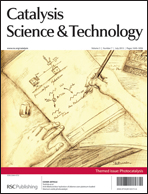A photosynthetic photosystem II (PS II) model was developed by adsorbing [(OH2)(terpy)MnIII(μ-O)2MnIV(terpy)(OH2)]3+ (1, terpy = 2,2′:6′,2′′-terpyridine) as an oxygen evolving center and Ru(bpy)32+ (bpy = 2,2′-bipyridine) as a photoexcitation center onto mica. The mica adsorbates were prepared by three different methods; Adsorbate A was prepared by adsorption of 1 followed by Ru(bpy)32+ on mica, and Adsorbates B and C were prepared by the opposite adsorption order and co-adsorption of 1 and Ru(bpy)32+, respectively. The UV-visible diffuse reflectance (DR) spectroscopic data and emission decay measurements of the photoexcited Ru(bpy)32+ suggested the different arrangements of 1 and Ru(bpy)32+ among the three adsorbates in a mica interlayer. For Adsorbate A, Ru(bpy)32+ could be adsorbed near the mica surface, being shallowly intercalated relative to 1. For Adsorbate B, 1 is adsorbed near the mica surface, Ru(bpy)32+ being deeply intercalated relative to 1. For Adsorbate C, either 1 or Ru(bpy)32+ could be randomly intercalated relative to the other adsorbates. In photochemical water oxidation experiments, a significant amount of O2 was evolved when visible light was used to irradiate an aqueous suspension of Adsorbate A containing a S2O82− electron acceptor in a liquid phase, whereas O2 was not evolved under the same conditions when using Adsorbates B and C. 1 is considered to work for photochemical water oxidation in Adsorbate A due to an efficient electron transport from deeply intercalated 1 to S2O82− ions in a liquid phase via Ru(bpy)32+ photoexcitation near the mica adsorbate surface.

You have access to this article
 Please wait while we load your content...
Something went wrong. Try again?
Please wait while we load your content...
Something went wrong. Try again?


 Please wait while we load your content...
Please wait while we load your content...